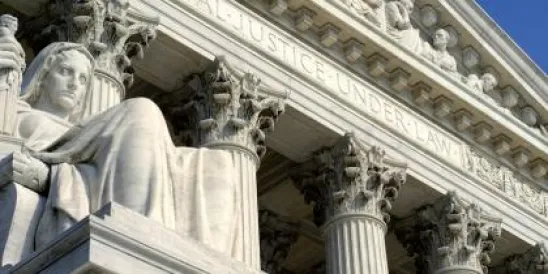The last Supreme Court term was a big one. Most observers will remember it as the term that upheld Obamacare, established a constitutional right to same-sex marriage, and introduced the American lexicon to “jiggery-pokery.” Those staying abreast of developments in the civil False Claims Act (FCA) jurisprudence, however, will remember the 2014 term for settling some uncertainty in regard to the FCA’s first-to-file bar and statute of limitations in Kellogg Brown & Root Services, Inc. v. United States ex rel. Carter, 135 S.Ct. 1970, __ U.S. ___ (2015). The full slip opinion can be found on the Supreme Court’s website, here; we previously covered the opinion, here.
The Carter holding on the Wartime Suspension of Limitations Act (WSLA) issue was welcomed by the government contracting community. Going forward, companies should expect no further litigation of the WSLA in the context of the civil False Claims Act, given that the Court held that the WSLA is truly designed to toll the statute of limitations on crimes and “offenses,” not allegations of routine civil fraud. Rather, litigation over the limitations period will be limited to whether the FCA’s six-year statute of limitations can be tolled for equitable reasons. This is a significant victory for defendants, who faced nearly unbounded liability for any claim that a so-called whistleblower could cook up years in the past. The prospect of a never-ending statute of limitations combined with the FCA’s potential for treble damages and civil penalties would have had ruinous consequences for industries submitting claims for payment of any kind to the federal government: government contractors would have been deterred from doing business with the federal government, health care entities would have been discouraged from accepting Medicare and Medicaid, and other industries would have faced significant risks for participating in federal programs or seeking federal dollars. So the unanimous ruling from the Court put a bit of common sense back in the FCA jurisprudence in regard to the WSLA.
The Court’s interpretation of the first-to-file bar, however, provides little comfort to FCA defendants in responding to allegations from so-called “whistleblowers.” The first-to-file bar states “[w]hen a person brings an action under [the qui tam provision of the FCA], no person other than the Government may intervene or bring a related action based on the facts underlying the pending action.” 31 U.S.C. § 3730(b)(5) (emphasis added). Departing from several Circuit Courts that had previously ruled differently, the Court interpreted the word “pending” to mean that a later suit is barred only if the first-filed suit is actually pending. The majority of Circuit Courts had previously considered “pending” to mean that a FCA case had been previously filed, and that the facts had been publicly disclosed. But this new ruling from the Court means that a new, parasitic FCA lawsuit might be allowed to continue, even when another, substantially similar FCA suit has been filed and then dismissed. The Court’s holding focuses on the procedural status of a particular case, not necessarily the key underlying facts. The Court’s holding, as the Court itself acknowledged, will “produce practical problems.” What will those practical problems look like?
The first potential problem is that of the previously dismissed case. A case that has been dismissed under the first-to-file bar might be refiled (so long as it is still timely under the FCA’s six-year statute of limitations). Carter might have opened the door to re-litigation of those previously dismissed matters. That’s a boon to the plaintiff’s lawyers, to be sure.
The second problem is trying to determine when an earlier case is actually “pending.” Imagine the following scenario: Let’s assume two qui tam cases share substantially the same facts. Qui tam #1 is filed on January 1. Qui tam #2 is filed on February 1. Qui tam #1 is dismissed on March 1 for failure to plead fraud with particularity under Federal Rule of Civil Procedure 9(b). The defendant in qui tam #2 moves to dismiss on April 1. Does the first-to-file bar apply? Although there would be no question that the first-to-file bar would apply between February 1 and March 1, the Supreme Court’s holding suggests that the answer is “no,” starting at the moment qui tam #1 is dismissed. The Court’s holding in this regard seems clear: “a qui tam suit under the FCA ceases to be ‘pending’ once it is dismissed.” The problem with this interpretation is that it diminishes the first-to-file bar’s jurisdictional character, thereby making it more likely that courts will begin to view the first-to-file bar as something other than a jurisdictional defense. While this might seem like legal legerdemain, whether the first-to-file bar is jurisdictional has serious real world consequences for defendants. Principal among them, the possibility that the first-to-file bar can be waived as a defense. Expect courts to struggle with reconciling long-standing precedent on the first-to-file bar’s jurisdictional status with the Carter ruling.
The third and final problem will take place during the negotiation of settlements. These days, the federal government is often declining to intervene and letting qui tam relators proceed with an action on its own. When that happens, the question becomes, “who is the defendant actually settling with?” The purpose of a settlement is to end a legal controversy once and for all. Under the Carter ruling, however, one could imagine a scenario where the government declines to intervene in qui tam #1, the defendant settles with qui tam #1 plaintiff, but then the second relator files qui tam #2 based on the same facts as qui tam #1. If the earlier case was settled, then does that bar the second relator? Under the Carter ruling, the answer is unclear.
As of this writing, the Carter decision has been cited in four decisions. None of those decisions have had to deal with these difficult interpretive issues regarding the FCA’s first-to-file bar. Based on our reading of the Carter ruling, however, it seems likely that courts will diminish the potency of the first-to-file bar in the coming years and up-end much of the existing jurisprudence. In the near term, litigants should not be surprised to see more cases asking these difficult questions. As the Supreme Court said in Carter, “[t]he False Claims Act’s qui tam provisions present many interpretative challenges, and it is beyond our [the Supreme Court’s] ability in this case to make them operate together smoothly like a finely tuned machine.”



 />i
/>i

